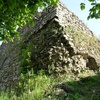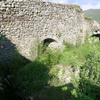Castle of Sillico
The village of Sillico rises on a hill in the Apennines of Garfagnana at about 700 metres above sea level. Its privileged location offers a view over the valley and the Apuan Alps.
The centre had been fortified with a polygon wall endowed with five circular towers, one of which was located in an east-facing corner, while the others defended the northern side. Access to the fort was twofold: a gate on the northern side and one on the southern side, near to the church. The massive square building of the fortress was positioned near the northern entrance, while at the opposite end the sentry post was presumably positioned in the bell tower. Only a few sections of the castle walls, which were still clearlyvisible in the early seventeenth century, remain.
Historical notes
From the tenth century, the village was dominated by the descendants of the noble house of Gherardinghi who only surrendered it to the City of Lucca at the end of the thirteenth century.
In 1376 Sillico is cited as "Castrum Sirici", a definition that testifies to the existence of the fortification towards the end of the fourteenth century, but it is not unlikely that the site had been previously equipped with some defence by the Gherardinghi.
As soon as the political stability in the State of Lucca began to falter, the inhabitants of the castle of Sillico did not hesitate to rebel against the governing authority and so, at the end of 1429, along with the community of Capraia, they were the first to place themselves under the protection of Niccolò d'Este, Marquis of Ferrara. Despite the damage it suffered during the wars between Lucca and Modena, the fort remained in use until the seventeenth century.











